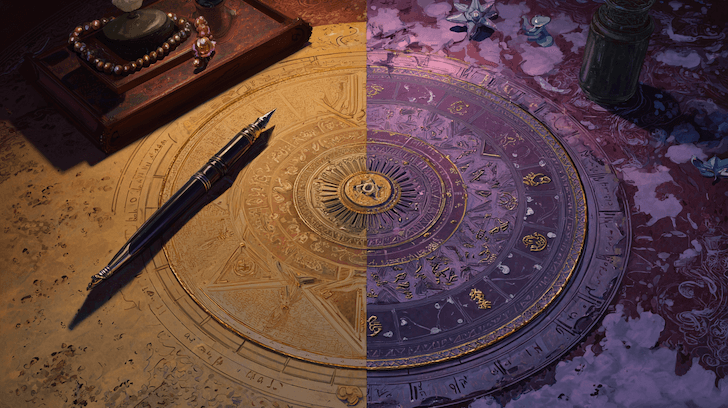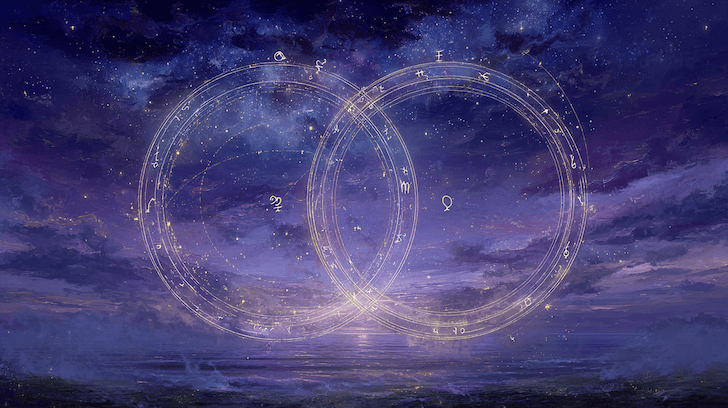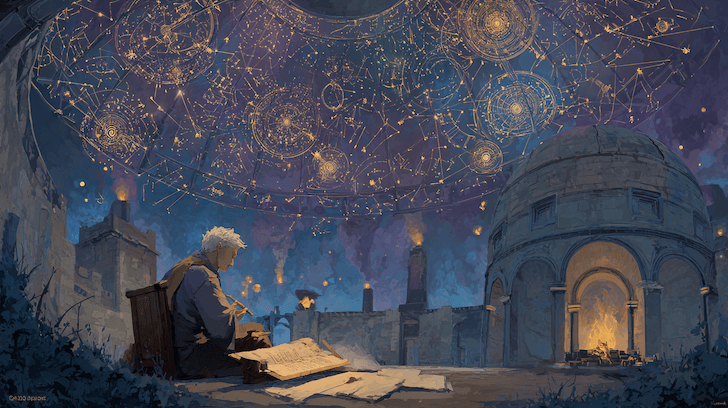Vedic Astrology vs. Western Astrology

Vedic and Western astrology both seek meaning in the movement of the heavens—but they speak different dialects of the same cosmic language. One looks to the fixed stars, the other to the seasonal Sun. One orients through karma and dharma, the other through character and psyche. Together, they show how astrology evolved into two great interpretive traditions, each precise and profound in its own way.
Vedic astrology (Jyotiṣa) is rooted in India’s sidereal zodiac and spiritual cosmology. Western astrology follows the tropical zodiac and emphasizes psychology, development, and symbolic timing.
Shared Roots, Divergent Paths
Both traditions descend from ancient sky-watching cultures—Mesopotamian omen systems, Egyptian decanal timing, and Greco–Indian exchanges in the early centuries BCE. Yet their historical contexts diverged:
| Era | Vedic (Jyotiṣa) | Western |
|---|---|---|
| c. 2nd c. BCE–2nd c. CE | Adopts sidereal zodiac and nakṣatras from Greco-Indian synthesis | Codifies tropical zodiac in Hellenistic Alexandria |
| c. 4th–10th c. CE | Develops daśā systems, divisional charts, and karma philosophy | Refines house systems, dignities, aspects, and predictive tools |
| Medieval to Renaissance | Continuity through Sanskrit commentaries | Adopted by Islamic and Latin scholars; later replaced by astronomy |
| 19th–21st c. | Continuous lineage through Indian priestly and scholarly schools | Revival through psychology, outer planets, and modern software |
While Western astrology spread and adapted, Vedic astrology maintained unbroken practice—refined across centuries of Sanskrit commentary and still taught within spiritual and academic lineages.
Core Structural Differences
| Feature | Vedic (Jyotiṣa) | Western |
|---|---|---|
| Zodiac Type | Sidereal (stellar-based, adjusts for precession) | Tropical (season-based, fixed to equinoxes) |
| Primary Chart | Janma Kuṇḍali (birth chart) with rāśis and bhāvas | Natal chart with signs and houses |
| House System | Equal 30° houses by sign (Whole Sign or Sripati variants) | Multiple systems (Placidus, Whole Sign, Koch, etc.) |
| Planetary Set | Seven classical planets + lunar nodes (Rāhu, Ketu) | Seven classical + Uranus, Neptune, Pluto, asteroids |
| Focus | Karma, dharma, timing, destiny | Personality, psychology, development, agency |
| Key Tools | Nakṣatras, daśās, yogas, vargas (divisional charts) | Aspects, transits, progressions, returns, asteroids |
Vedic Astrology (Jyotiṣa)
Derived from the Sanskrit word for “light,” Jyotiṣa views celestial motion as divine illumination of karma and dharma. It’s a sidereal system, aligning the zodiac with the stars. Its depth lies in timing and layered analysis—seeing not only what happens, but when.
- Uses sidereal zodiac aligned to constellations via an ayanāṃśa correction (usually Lahiri).
- Charts include rāśis (signs), bhāvas (houses), and grahas (planets, including lunar nodes).
- The nakṣatras—27–28 lunar mansions—add emotional and karmic nuance.
- Forecasting relies on daśā systems, especially Vimśottarī Daśā, assigning time periods to planetary rulers.
- Additional charts (vargas) refine readings: D9 for marriage, D10 for career, D12 for ancestry, and so on.
- Interpretation integrates spiritual philosophy: karma, reincarnation, and dharmic purpose.
In Jyotiṣa, events are seen as ripenings of karma. The chart is not fate—it’s a clock of when lessons and rewards unfold.
Western Astrology
Western astrology is tropical, aligning the zodiac to the equinoxes and solstices. It reflects seasonal cycles rather than constellational coordinates. Over time, it evolved from predictive technique into a language of psychological and symbolic understanding.
- Begins with the tropical zodiac, where 0° Aries starts the spring equinox.
- Adds outer planets—Uranus, Neptune, Pluto—representing collective and psychological forces.
- Focuses on character, development, and potential rather than karma or fate.
- Uses aspects, transits, progressions, and returns to describe timing and growth.
- Draws heavily on depth psychology and archetypal theory (Jung, Rudhyar, Greene).
- Encourages free will: astrology as mirror, not mandate.
Western astrology asks: “Who are you becoming?” Vedic astrology asks: “What is your destiny—and when does it unfold?”
Why Both Work
Despite their philosophical differences, both systems are internally consistent—their accuracy lies in symbolic coherence, not in which zero point they use. Each interprets the same sky through a different metaphysical frame.
- Both describe the same planetary cycles and angles, just measured differently.
- Both use symbolic logic—pattern recognition, repetition, and resonance—to read meaning.
- Both show clear results when applied consistently within their own rules.
In practice, many astrologers find that themes repeat across both systems even if sign positions shift. A planet’s house placement, rulership, or aspect often tells the same story in slightly different language.
Benefits of Each Approach
| System | Strengths | Best For |
|---|---|---|
| Vedic (Jyotiṣa) | Exceptional precision in timing and karma analysis; sophisticated predictive frameworks; continuity of tradition. | Understanding life purpose, spiritual cycles, marriage, career timing, and dharma. |
| Western | Psychological depth, flexibility, and personal development; rich integration with modern life and therapy. | Self-awareness, growth work, creative and relational exploration, planning and reflection. |
Bridging the Two
Some modern astrologers practice integrative astrology, comparing tropical and sidereal charts, or blending Jyotiṣa timing with Western psychological framing. Each perspective sharpens the other:
- Western astrology gives language for inner experience.
- Vedic astrology gives timing for outer manifestation.
Together, they outline both the script and its rehearsal schedule.
The wise student learns from both skies: the one that marks the seasons, and the one that holds the stars.
Conclusion
Vedic and Western astrology share a common ancestry but diverged in cosmology, technique, and purpose. One seeks to describe destiny in divine order; the other to understand the psyche in human terms. Both continue to evolve—and both can reveal profound truth when practiced with respect, rigor, and care.
Tropical vs. Sidereal Astrology

History of Astrology

Get Your Birth Chart
Calculate your complete astrological chart with precise astronomical data based on your birth time and location
Generate Chart